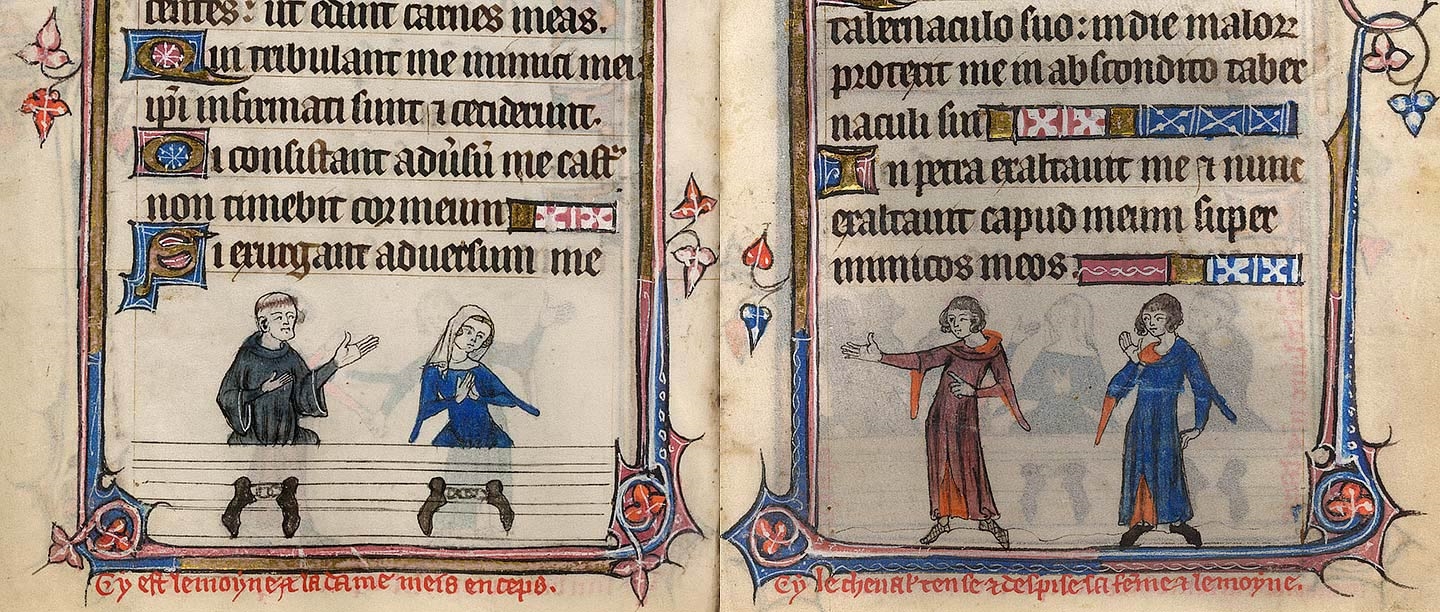Illicit encounters
The presence of women in the cloisters and dormitories of male monasteries was, in theory at least, strictly forbidden. On taking their vows, monks were expected to sever all connections with the outside world – even with their families.
The reality was somewhat different, however. Statutes issued after a visitation of the great abbey of Bury St Edmunds (Suffolk) in 1234, for example, said that no woman was to be led through the cloister to the refectory, infirmary or other buildings. Visits to monks by mothers, sisters and aunts to the cloisters of monasteries are all documented, even if technically prohibited.
Other visits were less innocuous. Despite taking a vow of chastity, monks – as the early fathers of medieval monasticism were all too aware – remained vulnerable to the sins of the flesh. In 1437 Bishop John Stafford of Wells had to order the walling up of ‘Sexteynegate’ – a postern, or subsidiary entrance – in the precinct wall of Muchelney Abbey (Somerset). The bishop expressed concern that the gate was being used to admit ‘women of loose character’ to the monastery.
There are several instances from the Dissolution era where abbots, priors and monks were accused of keeping concubines. The prior of Maiden Bradley, an Augustinian priory in Wiltshire, was said to have fathered six children and to possess a papal licence to ‘keep a whore’. The prior of Shulbrede, a small Augustinian house in East Sussex, was alleged to be intimate with no fewer than seven women, and his monks with four or five each.
There certainly were instances of monks having illicit romantic and sexual relationships with women. But such cases are more likely to have their origins in the fevered, anti-monastic imaginations of Henry VIII, Thomas Cromwell and their commissioners – looking to justify the closure of monasteries – than in reality. Nevertheless, they have helped form an idea of monasticism that remains deeply embedded in the popular psyche.
Punishment for monks who violated the rules could include flogging, or even imprisonment.
Servants
Nonetheless, there were legitimate reasons for women to enter the precincts of medieval monasteries.
One simple reason was that they employed large numbers of servants: a ratio of two or even three servants to each monk was not uncommon. Women were especially likely to be employed to do the laundry. Living outside the monastery, there was sometimes even the requirement that they should be respectable, ‘matronly’, married women.
Younger women could, however, find employment as milkmaids. Those at Battle Abbey (East Sussex) lived in the adjacent town. In 1507, the dairy at Sibton Abbey (Suffolk) was placed under the management of one Katherine Dowe. She more than earned her annual salary of £1, within six years doubling cheese production at the monastery. Katherine was also the author of didactic religious verse, advising: ‘Arise earelie/Serve God devoutly/Then to thy work bustlie.’
Visitors and residents
Monasteries had a sacred obligation to provide hospitality to pilgrims and travellers. Female visitors, however, were often lodged in a hostel outside the gates, and would be expected to worship in the gatehouse chapel rather than the monastic church.
Many medieval monasteries were home to corrodians. These were either retired servants who were provided with accommodation, food and fuel, or people who had paid a cash lump sum to live out their days within the precincts of a monastery. Corrodians at Cleeve Abbey (Somerset) and Rievaulx Abbey (North Yorkshire) are known to have included married couples, though in both cases they seemed to have been housed beyond the monastic perimeter. At Cleeve, for example, Stephen and Margaret Jobsons, who had done the abbey ‘a large pecuniary service’, were given lodging in a ‘great chamber beyond the gate’ in the early 16th century.
But there could be exceptions. In the early 16th century the recently widowed Lady Margaret de Vere lived in a mansion within the confines of Stratford Langthorne Abbey, close to London.
Pilgrims
Women could also visit monasteries as pilgrims, to venerate the relics of Christ and his saints that were enshrined in their churches. The relics of St Godric at Finchale Priory, near Durham, appear to have been especially popular with female pilgrims. Some modern scholars think that female pilgrims may have travelled to Finchale for cures in preference to Durham because of the supposed misogyny of St Cuthbert, whose relics rested behind the cathedral’s high altar.
The East Anglian mystic Margery Kempe made pilgrimages to saints’ shrines across Europe. In 1417, while visiting the famous relic of the Holy Blood at Hailes Abbey (Gloucestershire), she was overcome by ‘boisterous weeping’. Impressed by her religious fervour, the curious monks invited her into the cloister, access to which was usually strictly forbidden to pilgrims, especially women. There she promptly reprimanded some of the monks for their swearing. A female pilgrim plays an important role in one of the miracle stories from the abbey that date to about 1500.
But medieval monastic misogyny probably contributed to the disdain which the monks at Meaux Abbey (East Yorkshire) displayed towards the female pilgrims who came to venerate its miracle-working Rood – a sculpture of Christ on the cross – in the mid 14th century. The monks complained about the behaviour of these female pilgrims, saying they came out of mere curiosity rather than true devotion.
Female supporters
Women were prolific and at times extremely generous patrons of male monasticism. In the mid 12th century, Gundreda de Gournay took an active role in the foundation of Byland Abbey (North Yorkshire). She gave care and sustenance to the monks until her son, Roger de Mowbray, came of age and was able to assume patronage of the fledgling community. At least ten monasteries of Augustinian canons in England were founded by women in their own right, and a further eight were jointly established by a husband and wife.
Access by the laity – men and women alike – to monastic churches, the cloister and its surrounding buildings was usually strictly regulated. However, special provision was made for the founder and their family, and this could extend to women. On special holy days they would be allowed in the most sacred part of monastic churches to worship or to pray at the tombs of deceased family members.
Especially esteemed female patrons were even permitted to enter the cloister and its adjacent buildings. In 1517, the Queen of Sicily was given a tour of the great Cistercian monastery of Clairvaux in France.
Burial and commemoration
Anxieties about the presence of women within male monastic spaces was such that there are instances of abbots being admonished for permitting the burial of female patrons within their churches and cloister walks.
But the founder, his or her family and their descendants had the right be buried in the church or chapter house of the monastery they had established. This was an important privilege and was believed to hasten the passage of souls through the pains of Purgatory to bliss in heaven.
Although the uptight Cistercians had reservations about permitting the burial of women within their churches, in practice most monasteries took a pragmatic approach to the burial of their female patrons. From almost the moment of its foundation, female benefactors were securing burial at Furness Abbey (Cumbria). Their number included Alicia de Staveley, a generous patron of the abbey. She was laid to rest at the abbey in 1250–51, appointing the abbot as her executor and requesting the community to say prayers for the salvation of her soul.
When Joan de Mowbray, wife of John de Mowbray, descendant of Byland Abbey’s founder, died in 1349 (probably a victim of the Black Death), she was laid to rest before the monastery’s high altar – the best burial location of all. And a generation later, Matilda, Countess of Cambridge, was buried before the altar of the Virgin at Roche Abbey (South Yorkshire). Her will made generous gifts of vestments and altar plate to the monastery.
The burial of female patrons within male monastic churches continued until the very end of the English Middle Ages. In 1519, Dame Joan Huddleston was buried next to her husband, John (d.1512), in the chapel of St Nicholas at Hailes Abbey. Their tombs were located before the image of Our Lady of Pity (the Pietà). It was not uncommon for people to request burial before images of this type: the depiction of the Virgin grieving for her son, lying dead across her lap, recalled her role as a compassionate intercessor for humankind. The Virgin’s anguish and tears would have had a powerful emotional resonance for people mourning the death of a loved one.
Few had the wealth or status to merit burial within a monastic church. However, even the smallest of gifts to a monastery would be recorded in its Liber Vitae (Book of Life, or Book of Benefactors). The book was placed on the high altar and would be read through in its entirety once a year. In a very real sense, an entry in the benefactors’ book provided even the humblest of individuals, men and women alike, with a presence in the monastery.
Saints and relics
Women in the form of the Virgin Mary and female saints were the most welcome female presence in the lives of medieval monks – even in some instances a literal presence. At the end of the 12th century, Abbot Philip of Byland wrote a history of the foundation of Byland and nearby Jervaulx, describing how the Virgin Mary herself appeared in visions, not once but twice, to provide succour and guidance to the monks.
Byland and Jervaulx were Cistercian abbeys, and all monasteries of this austere, reforming order were dedicated to the Virgin. Depictions of the Virgin adorned the seals, walls and altars of monasteries across Europe. Her relics – portions of her clothing and even objects she had touched – were eagerly collected and prized by religious houses. Battle Abbey, for example, claimed fragments of her girdle, shift and veil and a portion of the tomb where her body rested before being miraculously ‘assumed’ into heaven.
Battle Abbey also had the relics of numerous other female saints, including the rib of St Helen – mother of Constantine the Great and finder of the True Cross – and the jawbone of St Brigid. The post-Conquest church at Whitby Abbey (North Yorkshire) was the resting place of the relics of St Hild, abbess of the great 7th-century monastery which had stood on the same site.
At the turn of the 12th century, the monks at Wenlock Priory (Shropshire) were delighted to discover the remains of another Anglo-Saxon abbess, St Milburga, who had ruled the 7th-century monastery there. Miracles were attributed to her relics, which the monks enshrined within their church.
Female saints provided an identity to many medieval male religious communities. Whitby Abbey was dedicated to St Hild (and St Peter): her feast day on 17 November was honoured at the abbey with especially elaborate religious services, feasting and general merrymaking. Similarly, Wenlock Priory was dedicated to St Milburga (and St Michael), and Milburga remained a potent presence at the monastery until the very end of the Middle Ages. The Wenlock monks wrote manuscripts containing prayers and devotional verse soliciting her help and intercession.
Whether as saints, benefactors, pilgrims, servants or even family members, women were a regular, constant, even an essential presence at medieval monasteries. And although some monks did transgress and breach their strict vow of celibacy, there is ample evidence that monks were more than capable of being in the presence of women while remaining true to their monastic vocations.
By Michael Carter
Top image: A monk and a woman in the stocks, from a 14th-century manuscript
© Courtesy British Library (Yates Thompson 13 fol 168v–169r)
Find out more
-
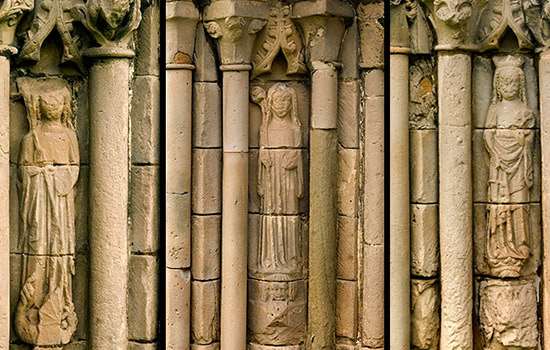
Women at Haughmond Abbey
Haughmond Abbey in Shropshire provides strong evidence of how much women were accepted and valued for their role in Christian belief and practice, even in a male monastery.
-
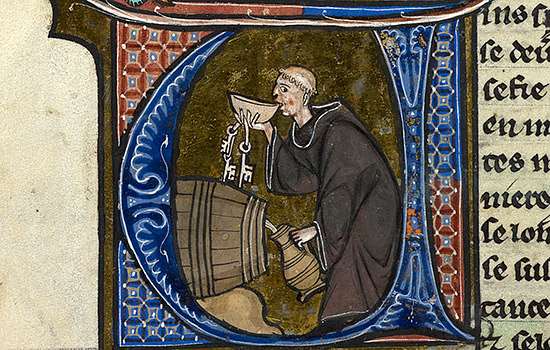
THE MISBEHAVING MONKS OF HAILES ABBEY
From visiting taverns to singing at the wrong pitch, the monks of Hailes Abbey couldn’t always meet the high standards expected of them.
-
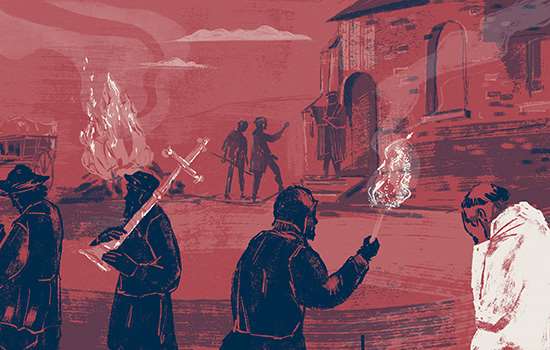
WHAT BECAME OF THE MONKS AND NUNS AT THE DISSOLUTION?
Discover what happened to the many thousands of monks and nuns whose lives were changed forever when, on the orders of Henry VIII, every abbey and priory in England was closed.
-
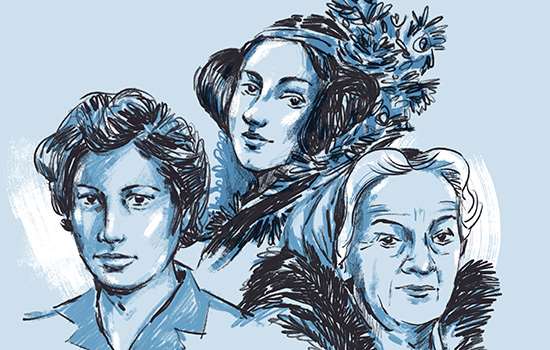
WOMEN IN HISTORY
Read about the remarkable lives of some of the women who have left their mark on society and shaped our way of life – from Anglo-Saxon times to the 20th century.
